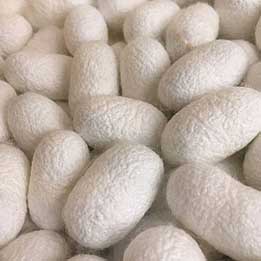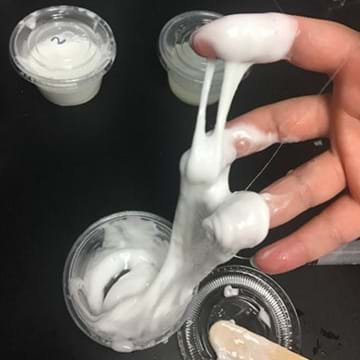Next Gen Engineering Design Aligned Curriculum
The TE hands-on activities featured here, by grade, focus on the engineering design component of the Next Gen standards.
- Be “Cool” with Popsicle Engineering Be “Cool” with Popsicle Engineering

Create popsicles using the engineering design process! In this activity, students work to solve the problems of a local popsicle shop while learning how scientific and engineering concepts play a part in behind-the-scenes design.
- Naturally Organized Naturally Organized

Design a customized table top supply organizer inspired by the natural home of a ladybug—or any other insect of a student's choosing—to hold all of their classroom supplies! By the end of this activity, students will understand the properties of biomimicry and the engineering design process.
- Invent a Backscratcher from Everyday Materials Invent a Backscratcher from Everyday Materials

Given scrap cardboard, paper towel tubes, scissors, and glue, how could a student invent their own backscratcher? Engage in the process of how real engineers design products to meet a desired function.
- Engineering an Animal’s Survival Engineering an Animal’s Survival
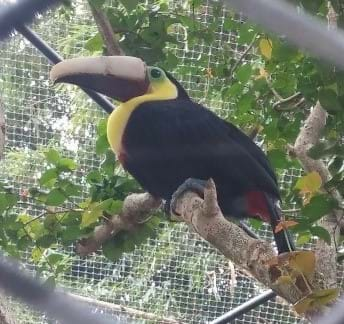
Students perform research and design prosthetic prototypes for an animal to use for its survival. They research a set of pre-chosen animals and their habitats. They then create habitats for their animals to live and model 3D prosthetics for the animals to use with modeling clay.
- Soil from Spoiled: Engineering a Compost Habitat for Worms Soil from Spoiled: Engineering a Compost Habitat for Worms
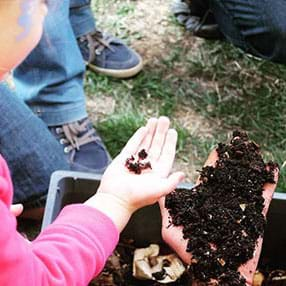
A unique activity for young learners that combines engineering and biology, students design an optimal environment for red wiggler worms in a compost bin.
- See More
- Test & Improve: Making Tall & Strong Recycled Towers Test & Improve: Making Tall & Strong Recycled Towers

Challenge students to design and build their own tower that is strong enough to withstand earthquakes and extremely high winds. And one more thing: their tower has to be made using only recycled materials!
- Engineering a Mountain Rescue Litter Engineering a Mountain Rescue Litter

When a person gets injured in the wilderness and needs medical attention, rescuers might use a device called a mountain rescue litter specifically designed for difficult evacuations. Design and build a small-sized prototype to save some (potatoes’) lives!
- Constraints: Pop Rockets on a Shoestring Budget Constraints: Pop Rockets on a Shoestring Budget

Your students have been hired to build a pop rocket, but on a tight budget. Engineering design usually has some constraints and you won’t always have access to the materials you think you might need. But through brainstorming and trial and error, a viable rocket launch is definitely possible!
- Clean Enough to Drink: Making Devices to Filter Dirty Water Clean Enough to Drink: Making Devices to Filter Dirty Water

Whether on Earth or in space, life-threatening illnesses may occur if the water we drink is of poor quality. It’s up to your students to design and build a filtration system for the International Space Station so they can guarantee astronauts get the safe and clean water they need.
- Exploring Variables While Testing & Improving Mint-Mobiles (for Elementary School) Exploring Variables While Testing & Improving Mint-Mobiles (for Elementary School)

Build a model race car out of lifesaver candies, popsicle sticks, straws, and other fun materials! Have students learn about independent, dependent, and control variables, and find out who can make the fastest car given their new knowledge.
- See More
- Small-Scale Modeling of Oil Spill Cleanup Methods Small-Scale Modeling of Oil Spill Cleanup Methods

Environmental engineers play a big role in the cleanup of oil spills. But how do you clean up a huge amount of oil that has been mixed in a body of water like the ocean? In this activity, students simulate a spill and cleanup and learn the effectiveness of different methods.
- Solving Everyday Problems Using the Engineering Design Cycle Solving Everyday Problems Using the Engineering Design Cycle

Marisol, a middle school student, struggles to keep their new locker organized. They need some ideas to design and implement a solution to solve this recurring problem. Have students use the engineering design cycle to help them!
- Operation Build a Bridge and Get Over It Operation Build a Bridge and Get Over It

Design and construct a bridge for a local city that will have a high strength-to-weight ratio and resist collapse. Have students use their understanding of the engineering design process—and a lot of wooden craft sticks—to achieve their goals.
- A Guide to Rain Garden Construction A Guide to Rain Garden Construction

Create a rain garden students can take home! In this activity, students build a green infrastructure dedicated to housing native species and learn about the importance of low-impact development technology.
- Renewable Energy Design: Wind Turbines Renewable Energy Design: Wind Turbines

Students get introduced to the real-world technical tool of a wind turbine propeller attachment. It’s a device that efficiently harvests wind energy, and in this activity they’ll build one of their own using a LEGO wind turbine, fan, and energy meter.
- See More
- Engineering Ethics: Evaluating Popular Inventions Engineering Ethics: Evaluating Popular Inventions

How do you define the word ‘ethical’? How do ethics and environmental and social impacts come into play throughout the engineering design process? Discover more by analyzing some world-renowned popular inventions in this activity.
- Creating Mini Wastewater Treatment Plants Creating Mini Wastewater Treatment Plants
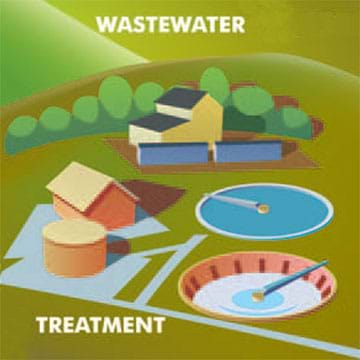
Student teams design, construct, test and improve small working models of water treatment plant processes to filter out contaminants and reclaim resources from simulated wastewater. They keep to a materials budget and earn money from reclaimed materials. They conduct before/after water quality tests...
- Concentrating on the Sun with Photovoltaic Solar Panels Concentrating on the Sun with Photovoltaic Solar Panels

How do solar panels capture energy from the sun? Have students build their own reflector and measure the solar energy output using only a photovoltaic panel, a multimeter, cardboard, and foil!
- Hurricane! Saving Lives via Logical Reasoning & Computer Science Hurricane! Saving Lives via Logical Reasoning & Computer Science

How might engineers keep people safe during a hurricane? Students use a hurricane tracking map to measure and graph how close the eye of a hurricane is from population centers, and then analyze MATLAB computer code generated by hurricane tracking data.
- Designing a Frictional Roller Coaster With Math and Physics! Designing a Frictional Roller Coaster With Math and Physics!

Build a small roller coaster prototype out of foam pipe wrap insulation and marbles, but apply calculus and physics in the design! This real-world engineering challenge applies practical mathematics to test small-sized models on a real track.
- See More
Why NGSS Engineering Design for K-12 Youth?
Engineering design promotes vital problem solving skills through project-based learning, while strengthening critical thinking skills. Engineering design-aligned curricula help develop students’ engineering habits of mind and design thinking by tying together multiple disciplines, and students working in teams to solve real-life problems they are passionate about!
The NGSS provide a foundation in engineering design that encourages students to design a wide range of solutions to problems that arise from phenomena. Anchoring learning in making sense of phenomena and using explanations of phenomena to design solutions well prepares K-12 students for college and careers.
What is Next Gen Three Dimensional Learning?
The NGSS are based on three dimensional learning. As outlined in the Framework, students make sense of phenomena by using Science and Engineering Practices (dimension 1) and applying Crosscutting Concepts (dimension 2), as well as Disciplinary Core Ideas (dimension 3). The integration of these three dimensions, all in service of making sense of phenomena, illustrates the importance — and interdependence — of content knowledge and practices that engage students both in scientific inquiry and engineering design.
Science and Engineering Practices (SEPs) describe the practices that scientists and engineers employ within their field. The SEPs help develop students’ knowledge of science and engineering while enhancing their aptitude with related practices.
The SEPs are comprised of:
- Asking Questions and Defining Problems
- Developing and Using Models
- Planning and Carrying Out Investigations
- Analyzing and Interpreting Data
- Using Mathematics and Computational Thinking
- Constructing Explanations and Designing Solutions
- Engaging in Argument from Evidence
- Obtaining, Evaluating and Communicating Information
Crosscutting Concepts (CCs) connect the various domains of science and allow students to better grasp and explore the interdependence between several science and engineering disciplines. The CCs provide students with an organizational scheme in which to understand the scientific world.
Crosscutting concepts address the following topics:
- Patterns
- Cause and Effect
- Scale, Proportion and Quantity
- Systems and System Models
- Energy and Matter
- Structure and Function
- Stability and Change
Disciplinary Core Ideas (DCIs) are a collection of ideas in science and engineering aimed to provide students with essential information that can be developed and integrated well beyond a student’s schooling. Thus, the DCIs help focus K-12 science curriculum.
The DCIs are grouped by the following domains:
Physical Sciences
- PS1: Matter and its Interactions
- PS2: Motion and Stability: Forces and Interactions
- PS3: Energy
- PS4: Waves and Their Applications in Technologies for Information Transfer
- LS1: From Molecules to Organisms: Structures and Processes
- LS2: Ecosystems: Interactions, Energy, and Dynamics
- LS3: Heredity: Inheritance and Variation of Traits
- LS4: Biological Evolution: Unity and Diversity
- ESS1: Earth’s Place in the Universe
- ESS2: Earth’s Systems
- ESS3: Earth and Human Activity
- ETS1: Engineering Design





